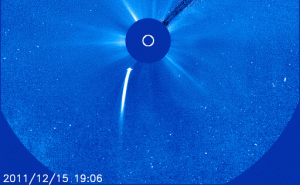Late last week scientists witnessed something they wouldn’t have considered possible if they hadn’t seen it for themselves.
At about 7:00 p.m. EST on Thursday, Dec. 15, an icy comet flew right through the multimillion-degree atmosphere of the sun – and survived fully intact.
As Comet Lovejoy passed through the solar corona, it came within approximately 140,000 kilometers of the sun’s surface.
Most scientific observers expected Lovejoy, which was first spotted on Dec. 2 2011, to be destroyed by the blazing heat. Instead, it survived, although it ended up much smaller after its close encounter with the sun.
The comet’s core was estimated to be about 500 meters in diameter before it plunged into the sun, which is what probably helped it survive the solar heat.

This coronagraph image from the Solar and Heliospheric Observatory shows Comet Lovejoy receding from the sun after its close encounter. Click on image to view animated version. (Image: NASA)
The comet’s journey was observed by NASA’s Solar Dynamics Observatory (SDO) and twin STEREO probes, Europe’s Proba2 microsatellite, and the ESA/NASA Solar and Heliospheric Observatory – all spacecraft which help keep track of the goings-on of the sun.
Of all of the images captured of the event, NASA’s footage is among the most compelling. The SDO caught Comet Lovejoy entering the sun’s scorching atmosphere and then coming back out again.
Although the comet did remain intact after its encounter with the sun, scientist Karl Battams of the Naval Research Lab in Washington, D.C., says Lovejoy’s days could be numbered.
“There is still a possibility that Comet Lovejoy will start to fragment. It’s been through a tremendously traumatic event. Structurally, it could be extremely weak. On the other hand, it could hold itself together and disappear back into the recesses of the solar system.”





















Passing through the corona at a height of 140,000 kilometers above the surface of the sun and it’s still intact! What is it made of?
Its not a comet! that would flat out be impossible. dont be fooled.
Damn right. Forget about the multi-million degrees C temperature, isn’t the shear gravity of the Sun powerful enough to gobble up or tear apart something as small as something just 500 meters across??? Your imagination opens up a Pandora’s Box of possibilities. Thanks for sparking up this debate. I’ll give it grave thought and keep posting my ideas. In the mean time I’d expect you to keep sharing your mind. Thanks again.
I have no doubt that the Comet’s makeup will be diagnosed differently as the scientists get past their euphoria and do more timely and accurate observations/investigation. You can’t break the laws of physics and chemistry just because of excitement and hyperbola. Hey guys I hate to break it to you – “there is no Santa Clause!”
Welcome to the club. You can’t break my heart by telling me, hey there’s no santa clause! I’m as atheist as they come. But the incident is mind boggling enough to cause euphoria even among the serious scientific community. Reminds of the Sci-Fi novel “Rama” by Arthur C. Clarke that I read way back in 1977. And I know today’s science fiction is tomorrows science. How many people took Tesla seriously when he had said that a day will come when we will hold small machines in our hands that will keep us connected to the rest of the world? “Never give up dreaming”, said Carl Sagan. Because that will be the death of scientific research. Newton had never thought someday Einstein will come and give a more comprehensive theory about the dynamics of cosmic bodies. And now Einstein’s Cosmic Constant is under threat if the results from the LHC at CERN, Fermi Lab and others about a faster than light neutrino proves to be true. So I can’t agree with you that the laws of physics and chemistry are unbreakable. They are true to the best of our knowledge today. But what do we know? Tomorrow is another day. Hamlet was right about his philosophical words to Horatio. I don’t know how old you are but I wish you to remain alive to see thinks like instant teleportation, parallel universes, wormholes, time travel etc. to become realities. Excitement is good man. Please keep this conversation alive. If nothing it’s good exercise for the brain. By the way it’s still 10 minutes to midnight over here. So here’s wishing you a Merry Christmas. Enjoy the holiday season. And what better time to dream!